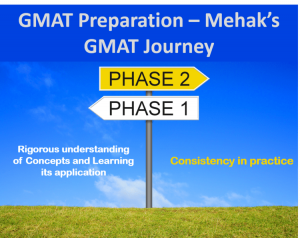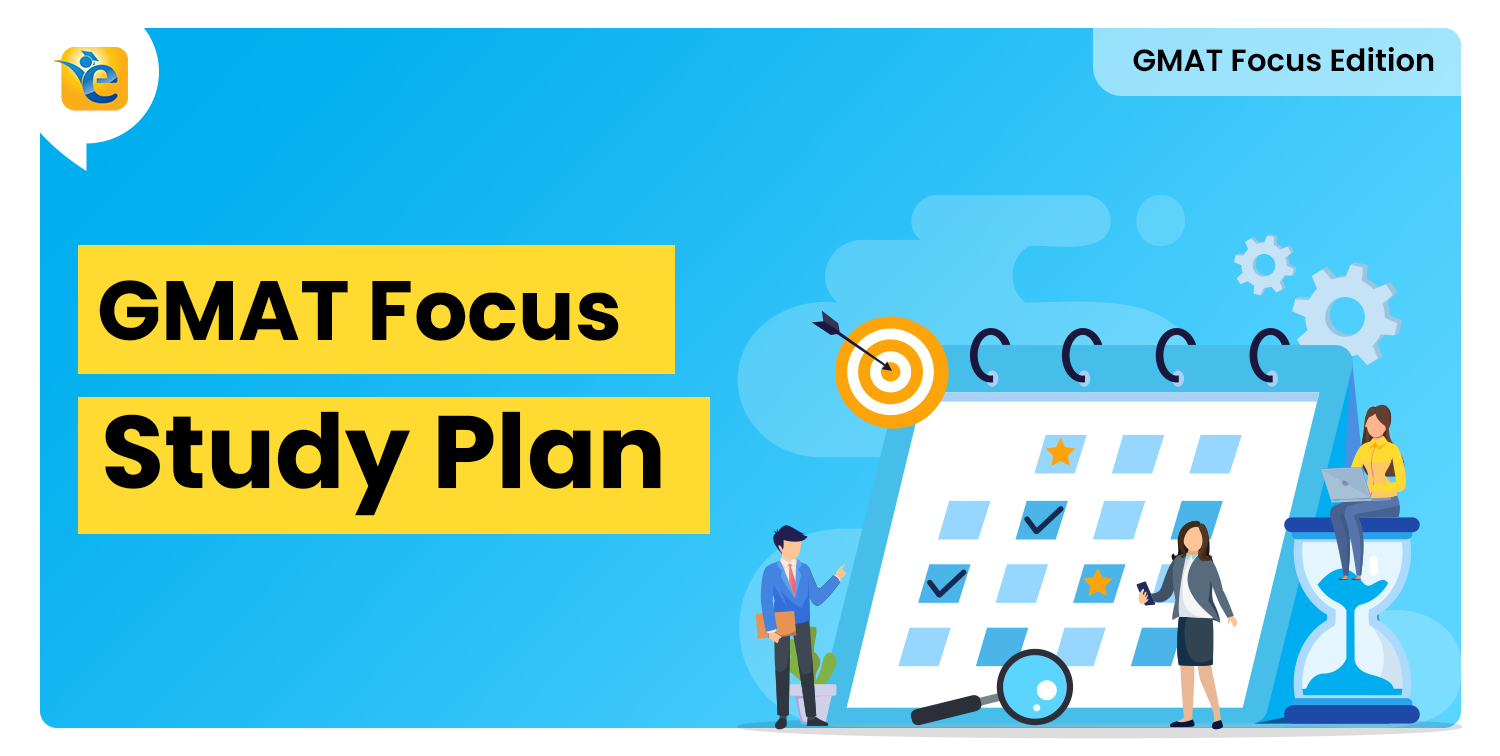GMAT Preparation is more about quality than quantity, and that’s what Mehak Khoja incorporated to score a 730 on the GMAT. She was able to increase her score from 640 to 730 within a few weeks! One of the key areas where she focused on was to maintain an error log to review correct/incorrect answers.
“You’re training for a Marathon, Not a Sprint.” – Mehak Khoja
Many of our students have also followed the same strategy where they understand the logic behind each answer choice. Check out the GMAT Success Story of Astitva and Jinna, who scored GMAT 770 (Q50, V44) and GMAT 760 (Q49, V44), respectively.
Mehak’s GMAT Preparation journey is divided into two phases:
- Phase 1: Rigorous understanding of Concepts and Learning its application
- Phase 2: Consistency in practice
Watch this video to know how you can also achieve a 700+ on the GMAT by following a methodological approach like Mehak. You can also read this article where we highlight her GMAT Journey and how she got into INSEAD MBA Program.
We can help you achieve your targeted GMAT score. Why don’t you try out our FREE Trial to get access to quality online GMAT Prep resources? We are the most reviewed online GMAT Prep company with 1950+ reviews on the GMATClub.
Here is the outline of the article:
GMAT Preparation Journey
Rajat: Congratulations on a 730. Let us talk briefly about your GMAT Journey.
Mehak: I approached my GMAT preparation by focusing on three main points:
- I went through the concepts of Quant and Verbal from scratch. Memorizing them again was quite reassuring.
- I maintained consistency in practice. It’s essential that you build your muscle memory, even if it is ten questions a day for each GMAT section. People often underestimate the importance of integrated reasoning because it is not part of your 800 scores. Please do not ignore the IR section and find a more straightforward way of doing it. Here are ten tips to ace the IR section.
Mehak read The Economist to practice for the IR section. She used to cover a particular article, look at the graphs, and find meaning out it. She states, “This process will also help you in your reading comprehension because you’ll be able to absorb things a lot faster and will be able to collaborate your insights from the one being presented by the author.”
- I maintained an Error Log for the question that I got right or wrong and then reviewed it. An error log will help you understand the thought process and the meaning behind a question.
For every question I got wrong, I would put it across three categories – Silly mistakes, time constraints, and lack of conceptual knowledge.
The above three points were manifested in six to seven weeks. To understand Mehak’s GMAT Journey, we have divided her prep into two phases.

Phase 1 – Strategy
Phase 1 was an intense phase where Mehak took time off work to prepare for the GMAT. The first two weeks were spent to understand all concepts rigorously.
Mehak: I went through each concept of Verbal and Quant. For Quant, I used Manhattan books, whereas, for Verbal, I used the e-GMAT course. I found the e-GMAT application file very helpful cause I am a learner that generally likes to apply things and understand them.
During this phase, Mehak spent about eight hours a day on average studying. She also made sure that she took breaks in the middle.
After the first two weeks, I had a little bit of practice but was able to recalibrate my concepts. So, I decided to take the test and scored 670.
There was a big jump that I needed to make, and it was only possible through creating muscle memory.
Phase 2 – Strategy
Phase 2 was when Mehak’s GMAT Date was just four weeks away, and her primary focus was on practicing and taking mock tests on the weekend.
Mehak: I am very big on consistency. For the next four weeks, I practiced 20 to 25 questions on weekdays during my lunch break. I focused on the Verbal section first and then Quant. During weekends I got more flexibility to practice.
At this phase of my Preparation, I maintained an Error log to know which answer choices are correct/incorrect and revisited the concepts if it was required.
How Data Powered Mehak’s GMAT Prep?

Mehak looked at her performance daily as a trendline. She noticed that most of her errors were coming from not knowing the concept and running out of time. Here are some Time management strategies that you can apply while preparing for the GMAT.
With the Data that was available to her through the e-GMAT platform, she found out that sentence correction was her weakest. Around 80-85% of her errors were in the SC section.
Mehak: I went through the entire curriculum of sentence correction again, without practice during the second of the fourth week. Week three onwards, I did some practice questions, which brought me to the fourth week.
At this point, when I recalibrated my practice results, I found out that my performance had dramatically improved. The questions that I was getting wrong was primarily stemming from silly mistakes.
It was reassuring because I realize that e-GMAT concepts files had given me an essential grammatical toolkit. I had also missed out on understanding the author’s meaning while approaching a sentence. That was a game-changer for me. It helped me even up those minor errors that were happening in RC.
At Week Four, Mehak was scoring 740-760 when she took the GMAT Official Guide Mock tests.
A Curve Ball Just One Week before the test
Mehak: I took another mock test on a Saturday and was back to a 670 on the GMAT. I went through my errors and realized that a bunch of those were coming from silly mistakes. I had just not paid enough attention.
The next day I did not do anything. It was a Sunday, and I realized that attention fatigue has steeped in. So, I decided not to take any tests on Sunday and Monday. I needed a break.
Tuesday, I did random practice questions, and on Wednesday, I took the mock test and was back to 700+. Next weekend was my last weekend before the GMAT so, I did two practice tests and got 710 and 730, respectively.
My recommendation is – Do not Overdose on writing tests, focus on method. Its Value over Volume any day when it comes to GMAT Preparation.
Mehak followed the e-GMAT approach to the deep. She understood that our approach is entirely process-driven, and following that process helped her increase her score.
If you also need help with your GMAT Prep, you can write to us at acethegmat@e-gmat.com. In the meantime, why don’t you try out our FREE Trial and get access to FREE GMAT online resources?
MBA Application for INSEAD – Prep Tips
Why INSEAD?

Mehak: It has always been a dream school for a variety of reasons. It is very highly ranked and has good brand equity. Also, my job entailed travel to the US, and I had gotten that North American feel and flavor out of the way. I wanted to go to Europe and get into a new culture.
I believe that diversity in terms of culture, schools of thought, and ideas are very critical for my learning. Thus, I wanted to pursue my MBA at a business school that values diversity, and INSEAD prides a lot on it.
Another thing that made me decide to go to INSEAD was the ROI. It’s a one-year MBA program, and if you even the average starting salary, you realize the ROI sooner than a two-year MBA program in the US. Know the diffrence between a one-year and a two-year MBA program.
Is an MBA worth it? Know the value of your investment here.
But to be honest with you, if I had to redo the process, I think my starting point was a bit incorrect. My starting point really should have been, what sector do I want to land in?
For anyone who’s making this decision, that’s how they should evaluate it.
I applied to three business schools and got into all of them, but for me, just from a purely financial perspective, it was INSEAD.
Mehak also got into Cambridge Business School and IMD Business School.
INSEAD MBA Application
Mehak did not hire any consultant to help her with the INSEAD MBA Application. She applied a methodological approach while creating her application, and it did pay off.
Mehak: I made an Excel sheet of 21 people that I know. I divided the list between alums, current students, and people who know me well (friends/family).
I created a storyboard that I felt was my Journey professionally and personally. After which I had one person from that list, which was my father, to review it. Then I had a friend check it, followed by a mentor at work.
Here is a brief outline of the steps followed by Mehak to craft her MBA Application:
- Reach out to people
- Get your storyboard ready
- Review your application
- Continuously tweak it
Check out how Tuhina, a current INSEAD MBA student crafted her application. Also, learn about Ariba Iqbal MBA application journey to INSEAD.
INSEAD Essay
The INSEAD Essay is for 2500 words split across eight essays. Here is the INSEAD MBA Essay analysis and tips for 2021 intake.
Mehak: I would recommend that you write the optional essay. A lot of people advised me not to use it and waste time, but I had a personal life story that I wanted to share with the Adcoms.
INSEAD MBA Application is very comprehensive, and you need to make sure that you do not repeat yourself.
So, even if you decide to use the optional space, make sure that it adds value.
I got my essays reviewed by my friends and family. I also checked with a few alumni because they had exposure to my industry and were best equipped to give me constructive feedback on my essay.
Did you know the average GMAT score for INSEAD MBA incoming class is 700+? We can help you achieve that score. Why don’t you try out our FREE Trial? We are the most reviewed Online GMAT Prep company with more than 1950 reviews on the GMATClub.















